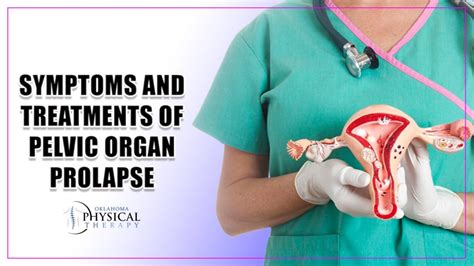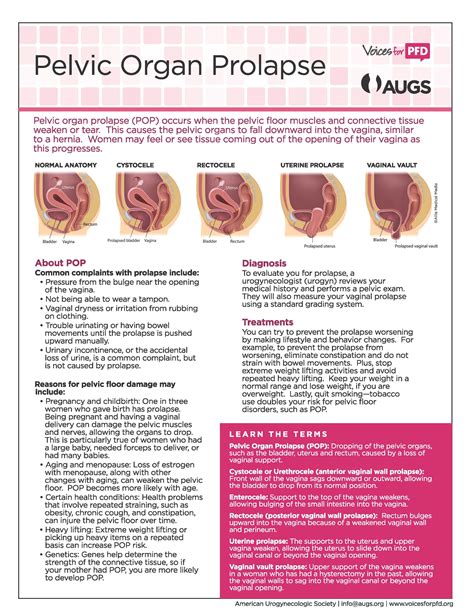Intro
The pelvic floor is a complex network of muscles, ligaments, and tissues that play a crucial role in supporting the bladder, uterus, and bowel. However, when these muscles and tissues become weakened or damaged, it can lead to a condition known as pelvic floor prolapse. This condition can cause a range of uncomfortable and debilitating symptoms, affecting a woman's quality of life and overall well-being. Understanding the symptoms and treatment options for pelvic floor prolapse is essential for women who are experiencing this condition.
Pelvic floor prolapse is a common condition that affects millions of women worldwide. It occurs when the muscles and tissues that support the pelvic organs become weakened, causing the organs to bulge or prolapse into the vagina. This can happen due to a variety of factors, including childbirth, menopause, aging, and certain medical conditions. Women who experience pelvic floor prolapse may notice a range of symptoms, including a feeling of heaviness or pressure in the vagina, pain or discomfort during sex, and difficulty emptying the bladder or bowel.
The symptoms of pelvic floor prolapse can vary from woman to woman, and in some cases, they may be mild and barely noticeable. However, if left untreated, the condition can worsen over time, leading to more severe symptoms and complications. It is essential for women to seek medical attention if they are experiencing any symptoms of pelvic floor prolapse, as early diagnosis and treatment can help alleviate symptoms and prevent long-term damage.
Pelvic Floor Prolapse Symptoms

The symptoms of pelvic floor prolapse can be divided into several categories, including vaginal symptoms, urinary symptoms, and bowel symptoms. Vaginal symptoms may include a feeling of heaviness or pressure in the vagina, a bulge or lump in the vagina, and pain or discomfort during sex. Urinary symptoms may include difficulty emptying the bladder, frequent urination, and urinary incontinence. Bowel symptoms may include difficulty emptying the bowel, constipation, and fecal incontinence.
Types of Pelvic Floor Prolapse
There are several types of pelvic floor prolapse, including cystocele, rectocele, enterocele, and uterine prolapse. Cystocele occurs when the bladder bulges into the vagina, while rectocele occurs when the rectum bulges into the vagina. Enterocele occurs when the intestine bulges into the vagina, and uterine prolapse occurs when the uterus slips out of its normal position and into the vagina.Treatment Options for Pelvic Floor Prolapse

The treatment options for pelvic floor prolapse depend on the severity of the condition, as well as the woman's overall health and medical history. Mild cases of pelvic floor prolapse may be treated with conservative measures, such as pelvic floor exercises, lifestyle modifications, and physical therapy. More severe cases may require surgical intervention, such as vaginal repair surgery or sacrocolpopexy.
Conservative Treatment Options
Conservative treatment options for pelvic floor prolapse include pelvic floor exercises, also known as Kegel exercises, which can help strengthen the muscles that support the pelvic organs. Lifestyle modifications, such as losing weight, quitting smoking, and avoiding heavy lifting, can also help alleviate symptoms. Physical therapy, including biofeedback and electrical stimulation, can also help strengthen the pelvic muscles and improve bladder and bowel function.Surgical Treatment Options

Surgical treatment options for pelvic floor prolapse include vaginal repair surgery, sacrocolpopexy, and hysterectomy. Vaginal repair surgery involves repairing the damaged tissues and muscles that support the pelvic organs, while sacrocolpopexy involves attaching the vagina to the sacrum, a bone in the lower back, to provide additional support. Hysterectomy, which involves removing the uterus, may be recommended in some cases, especially if the prolapse is severe and other treatment options have failed.
Risks and Complications of Surgery
As with any surgical procedure, there are risks and complications associated with surgical treatment for pelvic floor prolapse. These may include bleeding, infection, and injury to surrounding tissues and organs. Additionally, some women may experience recurrence of the prolapse, as well as new symptoms, such as urinary incontinence or bowel dysfunction.Prevention and Management of Pelvic Floor Prolapse

Preventing and managing pelvic floor prolapse requires a comprehensive approach that includes lifestyle modifications, pelvic floor exercises, and regular medical check-ups. Women can reduce their risk of developing pelvic floor prolapse by maintaining a healthy weight, quitting smoking, and avoiding heavy lifting. Regular pelvic floor exercises, such as Kegel exercises, can also help strengthen the muscles that support the pelvic organs.
Lifestyle Modifications
Lifestyle modifications, such as losing weight, quitting smoking, and avoiding heavy lifting, can help alleviate symptoms of pelvic floor prolapse. Women can also make dietary changes, such as increasing their fiber intake and staying hydrated, to help manage bowel and bladder function.Conclusion and Next Steps

In conclusion, pelvic floor prolapse is a common condition that affects millions of women worldwide. Understanding the symptoms and treatment options for pelvic floor prolapse is essential for women who are experiencing this condition. By seeking medical attention and working with a healthcare provider, women can develop a comprehensive treatment plan that includes lifestyle modifications, pelvic floor exercises, and surgical intervention, if necessary.
We invite you to share your thoughts and experiences with pelvic floor prolapse in the comments section below. If you have any questions or concerns, please do not hesitate to reach out to us. Additionally, we encourage you to share this article with friends and family members who may be experiencing pelvic floor prolapse, as it is essential to raise awareness and promote education about this common condition.
What are the symptoms of pelvic floor prolapse?
+The symptoms of pelvic floor prolapse may include a feeling of heaviness or pressure in the vagina, pain or discomfort during sex, and difficulty emptying the bladder or bowel.
What are the treatment options for pelvic floor prolapse?
+The treatment options for pelvic floor prolapse include conservative measures, such as pelvic floor exercises and lifestyle modifications, as well as surgical intervention, such as vaginal repair surgery and sacrocolpopexy.
Can pelvic floor prolapse be prevented?
+Yes, pelvic floor prolapse can be prevented by maintaining a healthy weight, quitting smoking, and avoiding heavy lifting. Regular pelvic floor exercises, such as Kegel exercises, can also help strengthen the muscles that support the pelvic organs.
